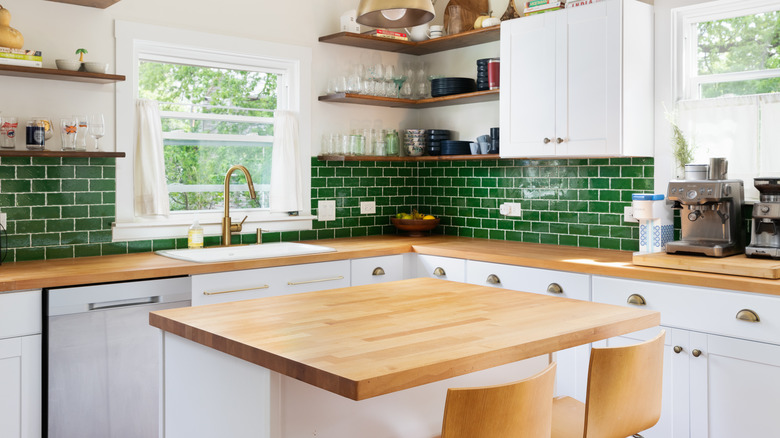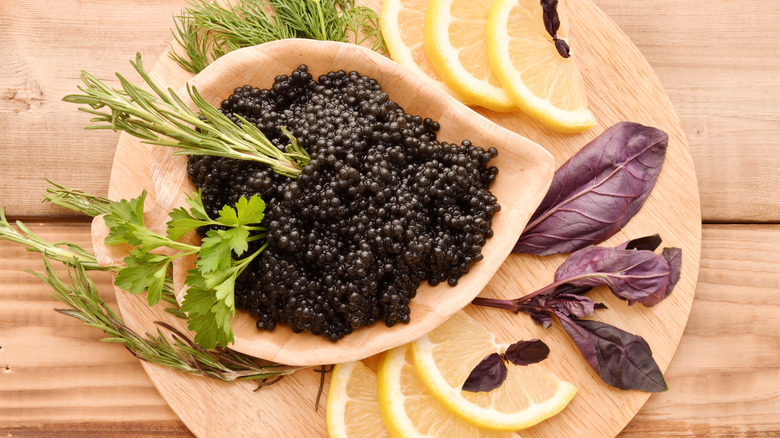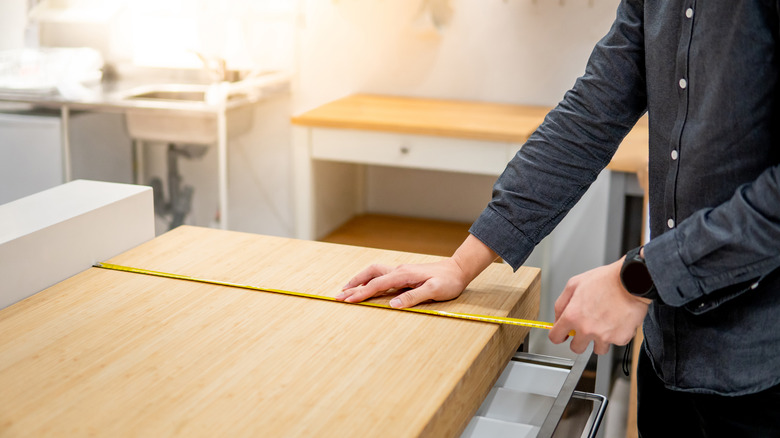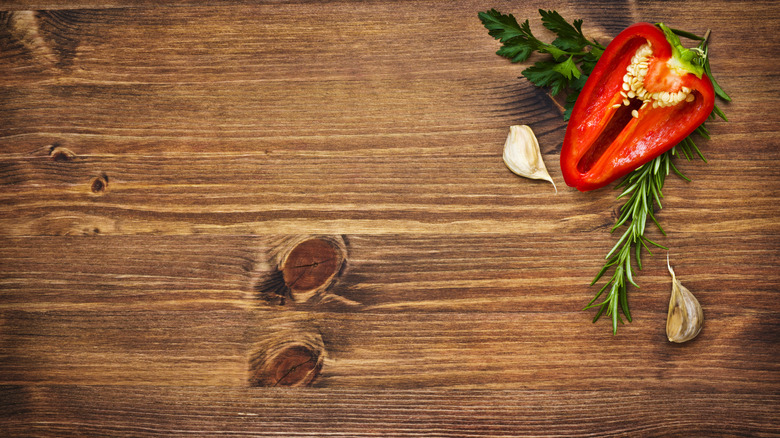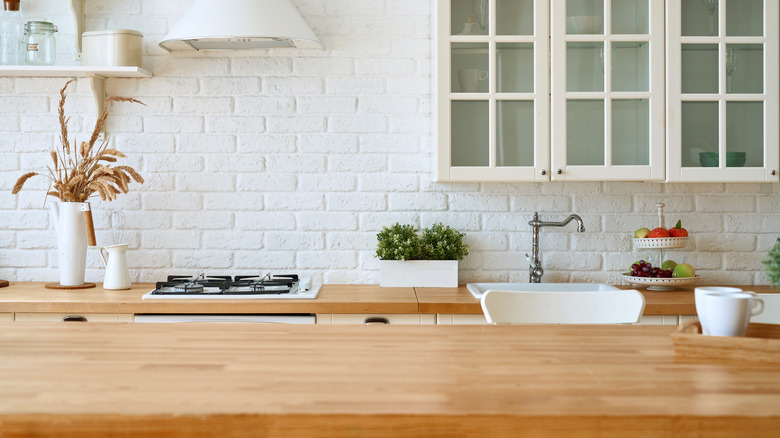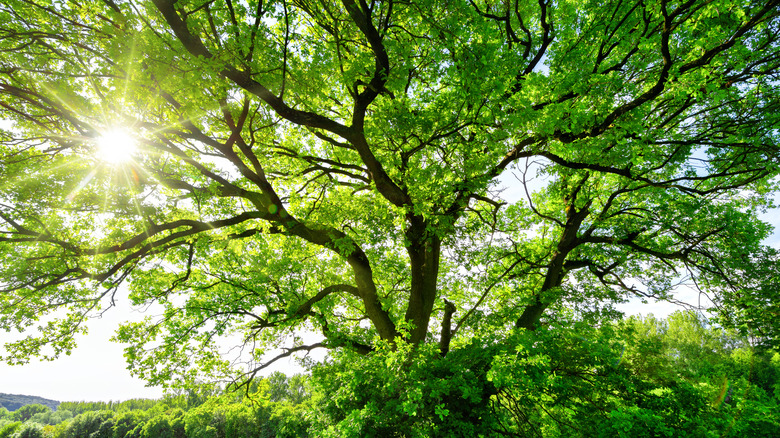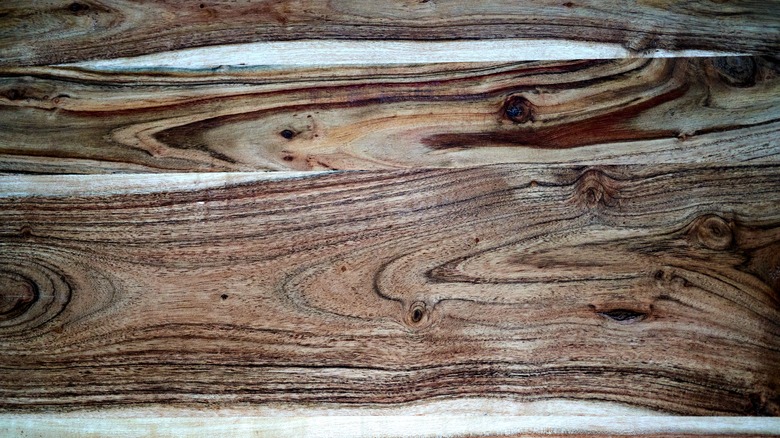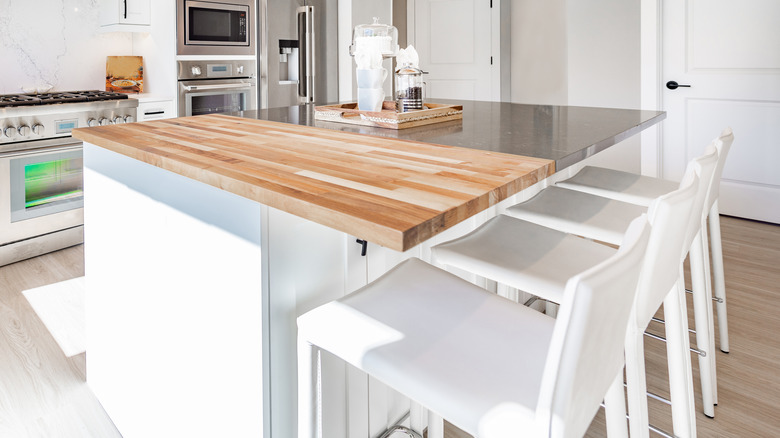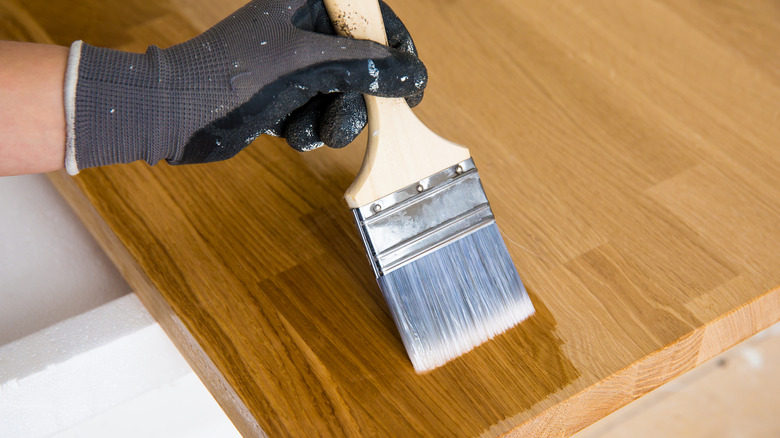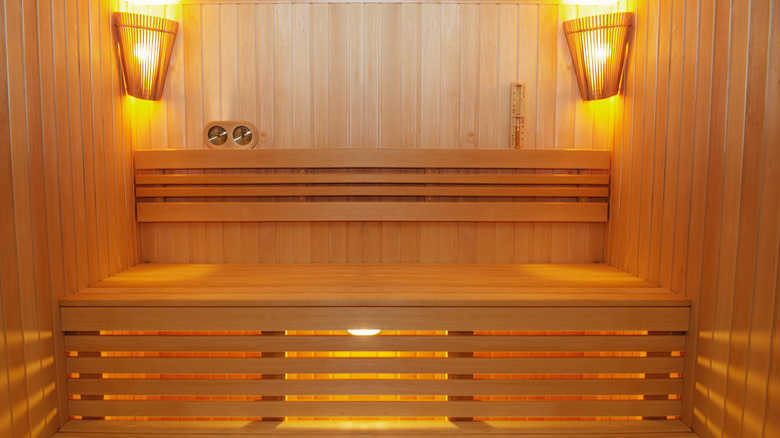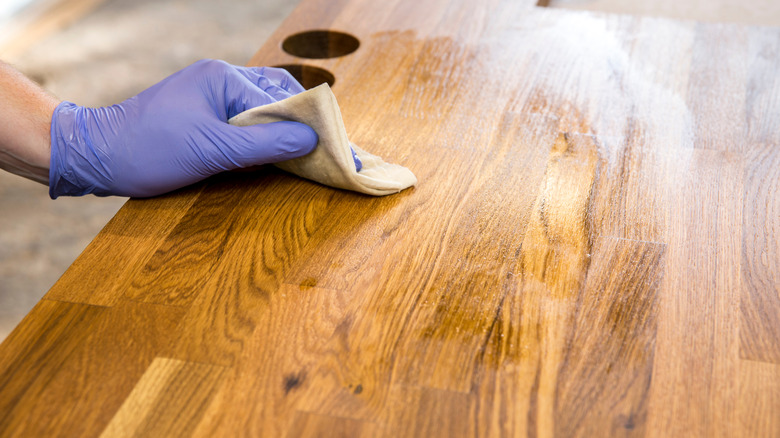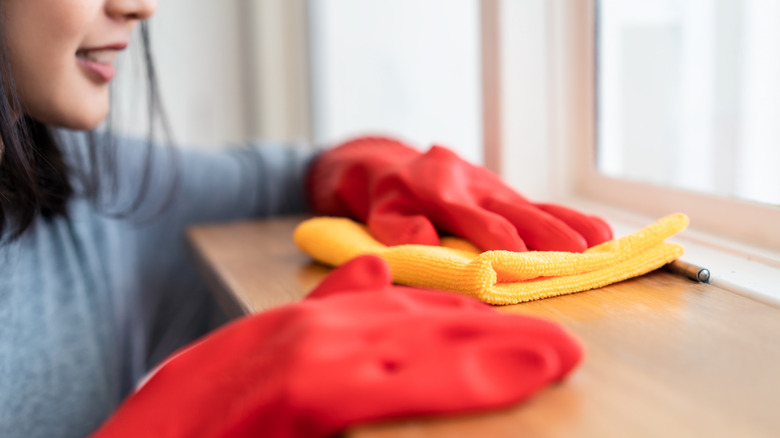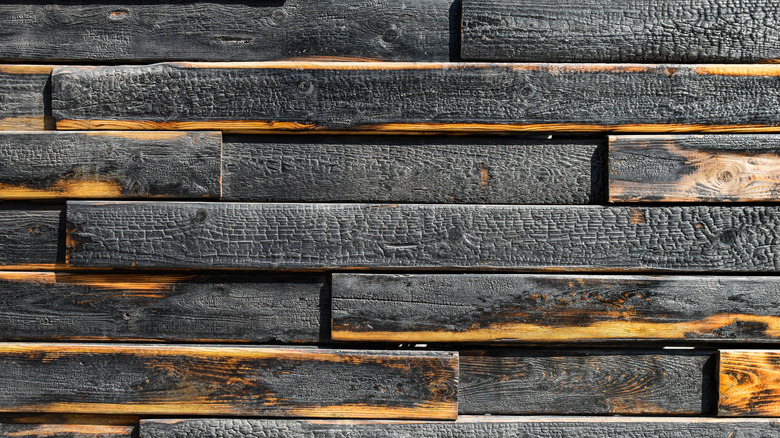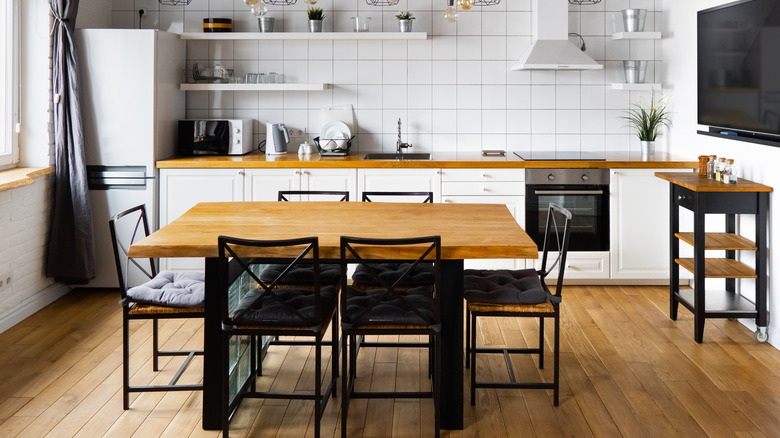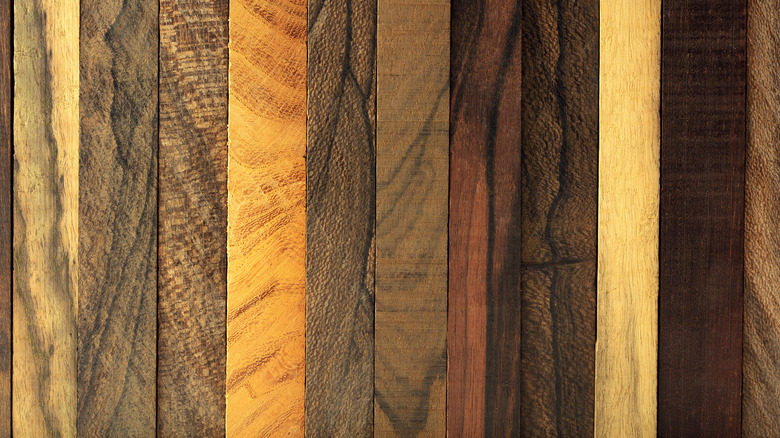What To Know Before You Buy Wood Countertops
There's nothing quite as warm and inviting in your home as wood. Whether for floors and furniture, voluptuous wood kitchen islands, or man cave bar tops, wood countertops bring nature into every room of your home. In a kitchen, these striking countertops are warmer than stone, more practical, and arguably more beautiful. With endless choices in woods, stains, and dyes, these natural countertops work as both focal points and accents. Solid wood or butcher block countertops, according to Forever Joint Tops, blend easily with decor styles from French Country to eclectic and Mediterranean.
But, like any well-used surface in your home, wooden countertops do require some care and maintenance and there are a few things to know. All wood and woodcuts are not created equally. This Old House says there are three types of wood grain — end, edge, and flat. Butcher blocks can be made from inexpensive edge-grain boards glued together on their sides. Chess or checkerboard pattern counters are made from lots of long square pieces of end grain wood. The DIYer or artisan can blend different woods to make geometric patterns with contrasting woods. Flat grain woods are cut for displaying the long beautiful grain. These long, wide boards are used by themselves or attached to others for a stunning countertop. No matter what type of wood countertop you choose, there are a few things to know before you buy.
Welcome to the wide world of wood prices
While overall, butcher block countertops are moderately priced, Angi says wood countertops range in price from $1,200 to $15,000 with most running between $2,000 and $5,000. With the average kitchen counter space being 50 feet according to Home Advisor, a new wood kitchen countertop can be comparatively inexpensive. This may give your budget some wiggle room to add more counter space like a breakfast bar, desktop, or island. Counter installation runs between $5 and $30 depending on your geographic area and the complexity of the project.
All the remodeling rage, reclaimed wood starts at $65 a foot, according to Designing Idea, and can give homeowners access to regional, unique, and old-growth woods that are not available on the mass market. Reclaimed and upcycled wood slab countertops, especially those with a live edge, keep the raw outer bark of the tree. This is a great way to add style and visual interest to any room. Walnut countertops themselves range in price from $20 to $100 a square foot while luxury teak costs $200 a square foot (via Home Advisor). There are also uncommon woods like pink-hued Lyptus and golden Iroko also known as African or Nigerian teak, that provide a definite wow factor, according to Brooks Custom. With wood, you can spend as much or as little as you want.
You can install them yourself
Any installation that requires exact measurements and understanding of how to work with wood is not the simplest of do-it-yourself tasks. If you've got the tools, the time, and the gumption, you can install a wood countertop. But just because you can install them yourself, doesn't mean that you should. If walls aren't straight and base cabinets are not all the same height, installing any countertops becomes more complicated... and frustrating. If you're game, aside from the countertop, according to Lowes, you'll need gloves, drop cloths, a tape measure, and 2-inch by 4-inch support boards. You'll also need a drill with bits and driver bits, and a saw with blades. Start by using the current countertop as a template, make your lines, and cut the wood counter to fit.
Then, with the countertop on the base cabinets, add some weight on the counters to hold them in place. Next screw in L-shaped braces to attach the new counter to the back of the cabinets, sinks, and other kitchen elements says The Spruce. Once secure, give them a light sanding, clean them off, and apply mineral oil as a sealant. Installing wood countertops is definitely a two-person job. If all this sounds like too much work, depending on your area, the professional installation runs between $5 and $15 per square foot, according to Home Advisor.
Can you make them yourself? Yes
Making a butcher block or wood countertop is easier than installing a heavy wood countertop. While butcher block boards are fabricated by gluing together long square pieces of strips of tight-grained wood, a wood countertop can be made with a nice piece of plywood. According to Home Depot, this project calls for a hardwood plywood. Choose a piece with an attractive side of maple, oak, or birch veneer. You'll also need wood trim, wood glue and filler, sandpaper, finish nails, a marker and straightedge, stain, sealant, and a saw (via Exquisitely Unremarkable). Cut the wood for the counter and wood for the edges and attach them together. Then, clean up with sandpaper and fill in nail holes with putty. Next comes applying layers of stain, letting them each dry, and finally applying sealant.
If you'd like an upgraded look, then use solid wood boards. Placed side by side, they can be glued or attached using biscuits, as Artsy Chicks Rule used in their wood countertop project. There are no edge or trim pieces needed for making this wood plank countertop. A polyurethane sealant is appropriate for bathrooms and areas that do not contact food or food prep. For kitchen counters, The Kitchn recommends using food-safe oils like walnut oil and beeswax while staying away from culinary oils that oxidize quickly and get sticky.
They can be budget-friendly
There is no ideal countertop material, as they all have their shortcomings, such as chipping, staining, and peeling, but wood countertops may be the closest to perfect. While kitchen counters are typically one of the most expensive items in a remodel, wood countertops are a great value. Prefab counters (like these from Ikea) run about $33 per foot. So, that means that a good-sized kitchen with 50 feet of counters can cost about $1,600. Using that 50-foot size, luxurious marble countertops at $75 to $250 a square foot, start at $3,750 and can be as much as $12,500. Sturdy granite and solid surface start at about $45 and can reach $200 a square foot, meaning the kitchen counters could run up to $10,000. Strong lava stone could cost $15,000 according to Countertop Guides.
Bob Vila likes the added warmth that wood countertops give and says that popular and affordable picks include bamboo and maple. For a great value, choose wood countertops made from suitable, tight grain, inexpensive woods like birch and beech. Keep in mind thicker woods are more expensive. And if your countertops start looking a little well-used? No worries! Nicks, dents, and knife marks on these attractive countertops can usually be quickly repaired inexpensively with some sandpaper and elbow grease.
Wood countertops make environmental sense
Made with new or reclaimed wood, wood is the countertop choice you can feel good about. Not only is wood a renewable resource, because it's lighter weight and easier to ship than slabs of granite, marble, or stone, wood is generally less expensive to transport. Keystone Granite says that long-distance shipping increases the price of the heavy stone counters. Cleaning wood countertops is also more environmentally friendly as they prefer cleansing without chemicals or abrasives. Instead, just clean them with warm soapy water.
While assessing eco-friendly countertops, Better Homes & Gardens touted both bamboo and reclaimed wood. Bamboo, actually a grass not a tree, and it is the fastest growing plant species on Earth. According to Science Focus, the moso variety of bamboo can grow over three feet a day. It regenerates quickly, and that's why bamboo countertops are good for the budget and the environment. While reclaimed or salvaged wood doesn't need to be harvested at all – except maybe from old buildings. When used as wooden countertops, these pieces add built-in character. When choosing not run-of-the-mill (ha, ha) woods, Jaaron Custom Wood Countertops reminds us that with many of the exotic woods hailing from South and Central America, it's important to find a reputable importer who uses sustainable and eco-friendly harvesting processing.
They're soft and strong
All trees and woods are not created equally. When choosing countertop woods, it's important to choose woods that are best for your use. Two ways to evaluate wood are by their hardness and their grain. Grain, according to Wood Magazine, is the structure, variation, and texture of the wood fibers. Fine-grained wood is generally the best choice for wood countertops. These woods have smaller, more closely-bunched cells so it's it better able to resist taking in moisture, mold, and mildew.
Denser wood is harder wood. Wood hardness is measured by the Janka Hardness Scale. By measuring the force necessary to push a small steel ball halfway into the piece of wood, reports Advantage Lumber, woodworkers have a scale of wood hardness. While ipe is the hardest wood, you only need a wood with moderate hardness for a countertop, such as oak, maple, or birch. Did you know wood countertops are soft enough to absorb sound? Countertop Advisor states that noises from appliances are muted by wood countertops, and are magnified by hard stone counters. This also means if you drop your coffee mug or dinner plate on a wood counter, they are less likely to shatter.
They play well with other countertops
No surface harmonizes with stone, solid surface, stainless steel, glass, and other woods better than natural wood. Mixing with all fixture finishes from black to bronze, wood countertops make your kitchen sing. With the warmth of their character, the varieties of tones, hues, grains, textures, and all the ways to incorporate their natural contours, wood countertops are fabulous additions offices and entertainment areas. They look and last like furniture, and make graceful additions to all types of decorating styles, from farmhouse to modern.
Although often used as a background countertop, wood makes a splash when featured in the kitchen and family gathering areas. The Decoist suggests using a lighter, brighter wood when installing a large island to keep the room feeling spacious. Birch, hard maple, and white oak are solid light-toned wood choices (via This Old House). Woods can create a centerpiece, especially lustrous dark woods. Some woods, like walnut, get darker with age, according to Ugly Duckling House... and so will ash, cherry, and maple. Specialty woods like warm curly maple, striped zebrawood, and coral-colored paduak (via Grothouse), can enhance your home's interior beauty.
Wood countertops move
We all know that trees breathe in carbon dioxide and release oxygen. But did you know that, even without their leaves, they continue to move, or what woodworkers call, "breathe"? Wood countertops move and change. Depending on the cut, style, and type of wood countertop, these size changes need to be accounted for in installation and care. During cool, dry winters, wood countertops condense, and in summer's hot, sultry days, they expand. According to Armani Fine Woodworking, countertops, especially butcherblocks, grow and shrink depending on changes in weather and humidity. They advise installing braces to allow for the wood to move and still have sturdy support.
It's also important to seal the entire countertop (via J. Aaron Custom Wood Countertops). They recommend sealing the bottom and top of the counter so the wood expands and contracts equally. Neglecting to seal the entire piece can lead to curling and cracking counters. Should your countertop develop a crack, SFGate suggests sanding, cleaning and prepping the area before applying food-safe glue, filler, or putty. They also advise using sawdust from your countertop and mixing it into the glue or filler to make sure the color matches perfectly.
They are sanitary on their own
Some woods are natural antibiotics. This fact isn't widely celebrated. How great would it be to have an attractive wood countertop that also kills germs? Think about the pungent aromas of cedar and eucalyptus trees. These essential tree oils, according to the NIH National Library of Medicine, have antibiotic properties. But what about the tree woods? Well, that's an interesting story. Seems that in the 1990s, the United States Department of Agriculture said that wooden cutting boards weren't as sanitary as plastic ones but had no proof or data. That prompted a number of scientists to investigate the government's claim. The analysts used ten types of wood (and four kinds of plastic) to test this hypothesis. They found that when properly sanitized, both wood and plastic cutting boards are safe for kitchen use.
Additionally, they also found that common food-borne microbes, including E.coli and salmonella, disappeared quickly on wood surfaces and the few that remained died quickly, while plastic cutting boards held living bacteria for a longer period of time. The scientists found that even in knife cuts and nicks, the wooden boards didn't house bacteria, unlike the plastic boards.
They require maintenance
Your wood countertop is where you chop, dice, and roll out dough. Often it's the center of the home and home cooking. Wherever your wood countertop is located, aside from keeping it clean, it's also vital to keep it moisturized and oiled monthly. So, the first order of business is oiling and sealing new wood countertops. It's as easy as rubbing in the oil, letting it dry, and wiping the counter clean. Where your countertop is located will help you determine what kind of oil is best to use.
Dwell recommends using mineral or tung oil. Mineral oil is a petroleum product, while tung oil is a nut oil. Used for millennia, tung oil gives wood water resistance, and brings out the wood's natural beauty, says Dutch Crafters. When choosing a mineral oil, Cutting Board says to look for USDA food-safe white mineral oil. Other options they suggest are beeswax, refractionated coconut oil, and carnuba wax.
It's important to keep the wood clean
While wood cutting boards may have anti-bacterial qualities, keeping them clean and sanitized is something necessary for the health of the family and the wood countertop. Assuming your wood is sealed, oil or wax are the only liquids we want to seep into the countertop. Keeping wooden countertops clean is simple, according to Dwell. Rule one is to quickly clean up spills, especially dark-colored liquids such as red wine, coffee, and tea.
Before oiling, give your wood a deep cleaning with some inexpensive household products: white vinegar, salt, lemon juice, and dish soap. Start by scraping off anything on the counter then scrubbing with the soapy sponge, according to HGTV. They suggest scrubbing with the wood grain. Rinse the wood and then apply vinegar and water. Once that's dry, make a paste made from one cup of lemon juice and a half-cup of salt and let the gritty salt mixture scrub the board. Then clean the paste off with a dry towel. Reader's Digest reports that baking soda can remove oils and sealants, so we suggest using regular soap and water for daily cleaning. Chemicals, abrasives, and commercial cleaners can all potentially damage, discolor, and dry out the wood.
Wood and hot pans don't mix
Wood countertops can be seriously damaged by hot pots, pans, and trays. While unlikely to catch fire, counters can be ruined by scorching hot kitchen items. McClure Block says that, contrary to popular thinking, butcher block countertops take the heat better than granite. They also comment that hardwoods can withstand more heat before burning than other countertops. But, exposing any countertop material to excessive heat is never advised, even for solid surfaces.
Intense heat can shock and warp stone, and wreck laminate. The best way to avoid any damage is to protect the surface with cooling racks or widely-available silicon mats. Should a blistering hot pan land on your surface, one major advantage to wood and butcher block countertops is that they are much easier and less expensive to repair. Wood n Beyond recommends repairing a burn by first sanding away the charred area, making sure to go with the wood grain. Then, using a damp towel, wipe the area clean and let it dry. Afterwards, rub in the protective oil until the mended area blends into the countertop.
Choose a wood that fills your needs
Before purchasing any wood countertop, decide how the surface is going to be used. For uses away from liquids and food, there are many more options both in wood and sealants. While close-grained woods are appropriate for kitchen and work space countertops, all grain sizes can be used for decorative purposes. Even soft woods like pine and spruce can be made extremely hard by applying finishes. There are two types of sealants: polyurethane and lacquer. SI Live says lacquers dry quickly and harden through evaporation while polyurethane is made from polymers, or plastics. If you want a durable finish, you want polyurethane. Not only does it repel water, but it still allows the wood to breathe, so it's great for bathrooms, pool houses, shower areas, and anywhere with lots of humidity.
Wood counters aren't just cabinet toppers. Been wondering what to do with that old bureau or dresser? Wanting to update that well-loved table? Ready to give that used desk a gorgeous new look? Yes, wood countertops are a fantastic way to customize and modernize furniture.
They can be made from many different wood varieties
While we know what regular butcher block and light wood countertops look like, there are dozens cool woods with interesting grains, colors, and textures to blend into your home. The versatile surface looks great with old world, tropical, and formal styles, according to Forever Joint Tops. Wood countertops can be in the background or take center stage. For a counter, some more attention-grabbing choices include Brazilian cherry, teak, and wenge (via The Spruce). The sturdy Brazilian cherry has an attractive reddish hue. The wood is light sensitive so it will darken to brown or deep claret color according to Impressions Flooring Collection. The medium-brown color of teak, says Aqua Teak, darkens over time. Brown wenge turns almost black when it's sealed. But unlike teak and cherry, wenge gets lighter with when it's in the sun, says The Wood Database.
Bold, hard, black-and-white-striped tigerwood, rustic wormy chestnut, and luxurious mahogany are more exotic choices (via Bob Vila). There's also Bubinga. Global Wood Source touts African bubinga wood which looks like rosewood. Used for furniture and veneer, its tones range from pink to red and purple. Don't like the natural colors? Food-safe dyes can also be used to stain wood countertops.
